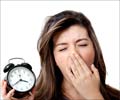Heart failure patients with untreated sleep apnea are more likely to die than those without this sleep disorder, says a study.
Heart failure patients with untreated sleep apnea are more likely to die than those without this sleep disorder, says a study.
The study followed 164 patients with heart failure for more than seven years, and found that those with obstructive sleep apnea (OSA) had double the death rate of those patients who did not have sleep apnea. Of the 37 patients with untreated OSA, the death rate was 24% in contrast to 12% for the 113 patients with no sleep apnea.Obstructive sleep apnea is common in patients with heart failure, and contributes to increased blood pressure, heart rate and other cardiac disturbances. This is the first time that the effect of obstructive sleep apnea on mortality rates of heart failure patients has been studied and reported.
“The vast majority of heart failure patients across North America are not being assessed for the diagnosis of sleep apnea and, as a result, are not being treated for it. Our data says that many of these patients need to be treated for this disorder and that this will have a significant impact on their survival,” said Dr. Douglas Bradley, Head of the Sleep Research Laboratories at Toronto General Hospital, Toronto Rehabilitation Institute, and Mount Sinai Hospital, and Director of the University of Toronto Center for Sleep Medicine and Circadian Biology.
More than 500,000 Canadians are treated for heart failure every year, with an additional 50,000 new cases every year. In the most severely affected, the one-year death rate can be as high as 40%, and it is the leading cause of hospital admission for individuals above the age of 65. Although drug therapy has reduced death rates in the last five to 10 years, and participation in a cardiac rehabilitation program can improve a patient’s quality of life by increasing stamina and decreasing shortness of breath, heart transplantation is the only long-term treatment for patients suffering from end-stage heart failure. However, because there is a severe shortage of donor hearts for transplantation, scientists are looking for alternate therapies. One such approach, suggested by the present study, is treatment of OSA in heart failure patients.
Obstructive sleep apnea occurs when a person stops breathing during sleep at least 15 to 20 times an hour. These recurrent interruptions in breathing deprive the brain of oxygen and activate the sympathetic nervous system, causing increases in blood pressure, heart rate and other disturbances. This, in turn, contributes to the progression of heart failure and mortality.
However, as Dr. Bradley pointed out, most heart failure patients don’t have the usual symptoms linked to OSA, which include: headache in the morning; loud snoring, restless sleep, or daytime sleepiness. “Sleep studies for heart failure patients are crucial in determining whether they have obstructive sleep apnea. Since the risk of death for these patients is significant, we need to be more vigilant in pursuing the diagnosis of obstructive sleep apnea in these patients,” he said.
Advertisement
Patients for the study were recruited from the Heart Failure Clinic of the Mount Sinai Hospital and the sleep studies were performed in sleep laboratories at Toronto General Hospital and the Toronto Rehabilitation Institute. In order to clearly determine the effect of sleep apnea, the characteristics of all the heart failure patients in the two groups were generally the same, including age, gender, severity of symptoms, medications, weight, and diabetes.
Advertisement
There were no deaths in the groups of 14 heart failure patients who had OSA and who were also treated with the CPAP device for at least three months. However, of the 37 patients with untreated sleep apnea, nine patients (24%) died. Patients in each group were similar in symptom severity, heart failure therapy and other factors.
Source-Newswise
SRM/B











